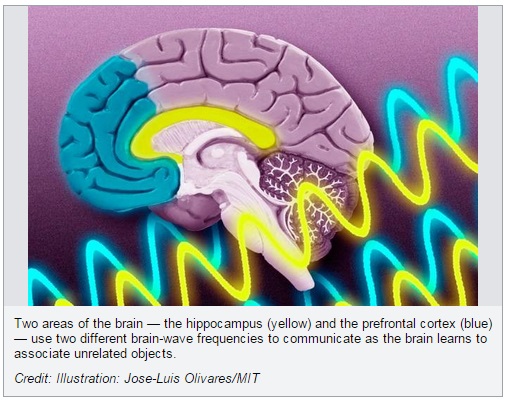How Brain Waves Guide Memory Formation
[Source: Science Daily]

Our brains generate a constant hum of activity: As neurons fire, they produce brain waves that oscillate at different frequencies. Long thought to be merely a byproduct of neuron activity, recent studies suggest that these waves may play a critical role in communication between different parts of the brain.
A new study from MIT neuroscientists adds to that evidence. The researchers found that two brain regions that are key to learning — the hippocampus and the prefrontal cortex — use two different brain-wave frequencies to communicate as the brain learns to associate unrelated objects. Whenever the brain correctly links the objects, the waves oscillate at a higher frequency, called “beta,” and when the guess is incorrect, the waves oscillate at a lower “theta” frequency.
“It’s like you’re playing a computer game and you get a ding when you get it right, and a buzz when you get it wrong. These two areas of the brain are playing two different ‘notes’ for correct guesses and wrong guesses,” says Earl Miller, the Picower Professor of Neuroscience, a member of MIT’s Picower Institute for Learning and Memory, and senior author of a paper describing the findings in the Feb. 23 online edition of Nature Neuroscience.
Read the Rest of this Article on Science Daily
“It’s like you’re playing a computer game and you get a ding when you get it right, and a buzz when you get it wrong. These two areas of the brain are playing two different ‘notes’ for correct guesses and wrong guesses,” says Earl Miller, the Picower Professor of Neuroscience, a member of MIT’s Picower Institute for Learning and Memory, and senior author of a paper describing the findings in the Feb. 23 online edition of Nature Neuroscience.
Read the Rest of this Article on Science Daily
PediaStaff is Hiring!
All JobsPediaStaff hires pediatric and school-based professionals nationwide for contract assignments of 2 to 12 months. We also help clinics, hospitals, schools, and home health agencies to find and hire these professionals directly. We work with Speech-Language Pathologists, Occupational and Physical Therapists, School Psychologists, and others in pediatric therapy and education.
